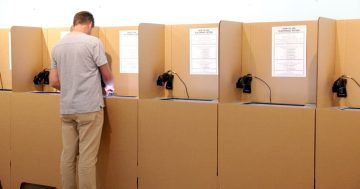
The ACT uses the Hare-Clark system to allocate votes. Photo: File.
Every four years Canberrans head to the polls to elect a new government, but many of us are just as confused as the next voter about how the Territory’s voting system works.
In a nutshell, each of the ACT’s five electorates will elect five members to the Legislative Assembly for a total of 25 MLAs. They are chosen via the Hare-Clark system – a voting process designed to fairly transfer preference votes in multi-member electorates.
Hare-Clark is a proportional representation voting system, which means that each candidate must currently receive 16.6 per cent of the total votes to be elected.
However, unlike the Federal system, Canberrans cannot choose to vote “above the line” for a single party. Instead, we must vote for individual candidates.
Voters mark ballot papers with the number 1 next to the candidate of their choice, then 2, 3, 4 and so on. At a minimum, voters are told to number as many boxes are there are seats to fill. On other words, five.
Papers will be counted up until the point at which preferences are exhausted, although your vote will still be counted as long as a first preference is shown. There is no maximum number of candidates to vote for, so you can rank everyone on the ballot paper if you wish.

A sample ballot paper for the ACT election. Photo: Elections ACT.
When a candidate receives more votes than the quota required to get elected, their surplus votes are then redistributed according to the preferences recorded by voters.
So if the quota to get elected is 10, and one candidate receives 12 votes, these two votes will be reallocated according to the number 2 preference marked on the ballot, but not at their full value. A second preference vote does not have equal value to a first preference vote.
If another candidate does not reach the quota after all surplus votes are redistributed, the candidate with the lowest votes is excluded and their preferences will be reallocated as well. This process is repeated until five candidates have a full quota of votes and are elected.
If you’re still confused, you’re probably not alone. Elections ACT, which oversees the “festival of democracy” (as Chief Minister Andrew Barr calls it), has made a video that uses visuals to explain how voting works in the ACT. More information and resources can also be found at Election ACT.
The election will be held on 17 October.





















